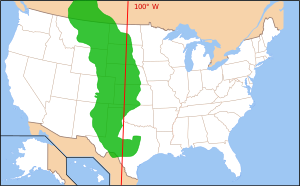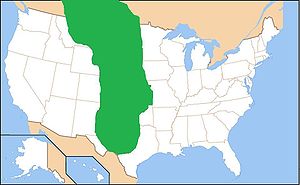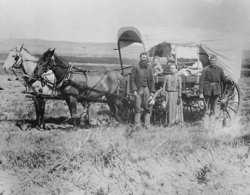Great Plains: Difference between revisions
m robot Modifying: ru:Великие Равнины |
No edit summary |
||
| Line 2: | Line 2: | ||
[[Image:Map of Great Plains.svg|thumb|300px|The Great Plains covers much of the central [[United States]], portions of [[Canada]] and [[Mexico]]. The [[100th meridian west]] is denoted with the red line.]] |
[[Image:Map of Great Plains.svg|thumb|300px|The Great Plains covers much of the central [[United States]], portions of [[Canada]] and [[Mexico]]. The [[100th meridian west]] is denoted with the red line.]] |
||
[[File:Map of Great Plains2.jpg|thumb|300px|The Great Plains as defined by the Center for Great Plains Studies at the [[University of Nebraska-Lincoln]].]] |
[[File:Map of Great Plains2.jpg|thumb|300px|The Great Plains as defined by the Center for Great Plains Studies at the [[University of Nebraska-Lincoln]].]] |
||
| ⚫ | The during the mid/late 1800s. It has an area of approximately 1,300,000 km<sup><small>2</small></sup> Some current thinking regarding the geographic location of the Great Plains is shown by a [http://www.unl.edu/plains/about/map.shtml map] at the Center for Great Plains Studies at the [[University of Nebraska-Lincoln]]. |
||
The '''Great Plains''' are the broad expanse of [[prairie]] and [[steppe]] which lie west of the [[Mississippi River]] and east of the [[Rocky Mountains]] in the [[United States]] and [[Canada]]. This area covers parts of the [[U.S. state]]s of [[Colorado]], [[Kansas]], [[Montana]], [[Nebraska]], [[New Mexico]], [[North Dakota]], [[Oklahoma]], [[South Dakota]], [[Texas]] and [[Wyoming]], and the [[provinces and territories of Canada|Canadian provinces]] of [[Alberta]], [[Manitoba]] and [[Saskatchewan]], and into Mexico. In Canada the term ''prairie'' is more common, and the region is known as the [[Prairie Provinces]] or simply "the Prairies". |
|||
| ⚫ | The |
||
==Geology== |
==Geology== |
||
Revision as of 17:06, 24 August 2009


The during the mid/late 1800s. It has an area of approximately 1,300,000 km2 Some current thinking regarding the geographic location of the Great Plains is shown by a map at the Center for Great Plains Studies at the University of Nebraska-Lincoln.
Geology

The Great Plains are the westernmost portion of the vast North American Interior Plains, which extend east to the Appalachian Plateau. The United States Geological Survey divides the Great Plains in the United States into ten physiographic subdivisions:
- Missouri Plateau, glaciated – east-central South Dakota, northern and eastern North Dakota and northeastern Montana
- Missouri Plateau, unglaciated – western South Dakota, northeastern Wyoming, southwestern South Dakota and southeastern Montana
- Black Hills – western South Dakota
- High Plains – eastern New Mexico, northwestern Texas, western Oklahoma, eastern Colorado, western Kansas, most of Nebraska (including the Sand Hills) and southeastern Wyoming
- Plains Border – central Kansas and northern Oklahoma (including the Flint, Red and Smoky Hills)
- Colorado Piedmont – eastern Colorado
- Raton section – northeastern New Mexico
- Pecos Valley – eastern New Mexico
- Edwards Plateau – south-central Texas
- Central Texas section – central Texas
The High Plains is used in a related, more general context to describe the elevated regions of the Great Plains, which are primarily west of the 100th meridian. The 100th meridian roughly corresponds with the line that divides the Great Plains into an area that receive 20 inches (500 mm) or more of rainfall per year and an area that receives less than 20 inches (500 mm). In this context, the High Plains is semi-arid steppe land and is generally characterized by rangeland or marginal farmland. The region is periodically subjected to extended periods of drought; high winds in the region may then generate devastating dust storms.
During the Cretaceous Period (145-65 million years ago), the Great Plains was covered by a shallow inland sea called Western Interior Seaway. However, during the Late Cretaceous to the Paleocene (65-55 million years ago), the seaway had begun to recede, leaving behind thick marine deposits and a relatively flat terrain where the seaway had once occupied.
History
Pre-European contact
Historically, the Great Plains were the range of the bison and of the Great Plains culture of the Native American tribes of the Blackfeet, Crow, Sioux, Cheyenne, Arapaho, Comanche and others. Eastern portions of the Great Plains were inhabited by tribes who lived in semipermanent villages of earth lodges, such as the Arikara, Mandan, Pawnee and Wichita.
European contact
With the arrival of Francisco Vásquez de Coronado, a Spanish conquistador, the first recorded history of Europeans in the Great Plains happened in Texas, Kansas and Nebraska from 1540-1542. In that same time period, Hernando de Soto crossed a west-northwest direction in what is now Oklahoma and Texas. Today this is known as the De Soto Trail. The Spanish thought the Great Plains were the location of the mythological Quivira and Cíbola, a place rich in gold.
In the next one hundred years the fur trade injected thousands of Europeans onto the Great Plains, as fur trappers from France, Spain, Britain, Russia and the young United States made their way across much of the region. With the Louisiana Purchase in 1803 and subsequent Lewis & Clark Expedition in 1804, the Great Plains became more accessible. A major fur trading site was located at Fort Lisa on the Missouri River in Nebraska. This type of early settlement opened the door to vast westward expansion, with settlements rising across the Great Plains.
Early settlements on the Great Plains
- Fort Manuel Lisa Trading Post (1806)
- Fontenelle's Post (1806)
- Cabanne's Trading Post (1822)
Pioneer settlement

This settlement led to the near-extinction of the bison and the removal of the Native Americans to Indian reservations in the 1870s. Much of the Great Plains became open range, hosting ranching operations where anyone was theoretically free to run cattle. In the spring and fall, roundups were held and the new calves were branded and the cattle sorted out for sale. Ranching began in Texas and gradually moved northward. Texas cattle were driven north to railroad lines in cities Dodge City, Kansas and Ogallala, Nebraska; from there, cattle were shipped eastward. Many foreign, especially British, investors financed the great ranches of the era. Overstocking of the range and the terrible winter of 1886 eventually resulted in a disaster, with many cattle starved and frozen. From then onward, ranchers generally turned to raising feed in order to keep their cattle alive over winter.
The Homestead Act of 1862 provided that a settler could claim up to 160 acres (65 hectares) of land, provided that he lived on it for a period of five years and cultivated it. This was later expanded under the Kinkaid Act to include a homestead of an entire section. Hundreds of thousands of people claimed these homesteads, sometimes building sod houses out of the very turf of their land. Many of them were not skilled dryland farmers and failures were frequent. Germans from Russia who had previously farmed in similar circumstances in what is now Ukraine were marginally more successful than the average homesteader. The Dominion Lands Act of 1871 served a similar function in Canada.
After 1900

The region roughly centered on the Oklahoma Panhandle, including southeastern Colorado, southwestern Kansas, the Texas Panhandle, and extreme northeastern New Mexico was known as the Dust Bowl during the late 1920s and early 1930s. The effect of the drought combined with the effects of the Great Depression, forced many farmers off the land throughout the Great Plains.
From the 1950s, on, many areas of the Great Plains have become productive crop-growing areas because of extensive irrigation. The southern portion of the Great Plains lies over the Ogallala Aquifer, a vast underground layer of water-bearing strata dating from the last ice age. Center pivot irrigation is used extensively in drier sections of the Great Plains, resulting in aquifer depletion at a rate that is greater than the ground's ability to recharge.
The rural Plains have lost a third of their population since 1920. Several hundred thousand square miles of the Great Plains have fewer than six persons per square mile—the density standard Frederick Jackson Turner used to declare the American frontier "closed" in 1893. Many have fewer than two persons per square mile. There are more than 6,000 ghost towns in the State of Kansas alone, according to Kansas historian Daniel Fitzgerald. This problem is often exacerbated by the consolidation of farms and the difficulty of attracting modern industry to the region. In addition, the smaller school-age population has forced the consolidation of school districts and the closure of high schools in some communities. This continuing population loss has led some to suggest that the current use of the drier parts of the Great Plains is not sustainable, and propose that large parts be restored to native grassland grazed by bison, a proposal known as Buffalo Commons.
Wind power
The Great Plains contribute substantially to wind power in the United States. In July 2008, oilman turned wind-farm developer, T. Boone Pickens, called for the U.S. to invest $1 trillion to build an additional 200,000 MW of wind power nameplate capacity in the Plains, as part of his Pickens Plan. Pickens cited Sweetwater, Texas as an example of economic revitalization driven by wind power development.[1][2][3] Sweetwater was a struggling town typical of the Plains, steadily losing businesses and population, until wind turbines came to the surrounding Nolan County.[4] Wind power brought jobs to local residents, along with royalty payments to landowners who leased sites for turbines, reversing the town's population decline. Pickens claims the same economic benefits are possible throughout the Plains, which he refers to as North America's "wind corridor."
Flora
The Great Plains are part of the floristic North American Prairies Province, which extends from the Rocky Mountains to the Appalachian mountains.
See also
- 1837-38 smallpox epidemic
- Canadian Prairies
- Great American Desert
- High Plains (Australia)
- Cerrado, Brazil
- Llano Estacado, Southwest United States
- Llanos, Colombia and Venezuela
- Pampa, Argentina, Paraguay, Brazil
- Steppe
- Wind power in Texas
- Great bison belt
References
Bibliography
- Paul Bonnifield, The Dust Bowl: Men, Dirt, and Depression, University of New Mexico Press, Albuquerque, New Mexico, 1978, hardcover, ISBN 0-8263-0485-0.
- D. H. Fairchild and J. E. Klete, Woody Landscape Plants for the High Plains, Colorado State University, 1993, Technical Bulletin LTB93-1 (Contact CSU to buy this).
- Merrill Gilfillan, Chokecherry Places, Essays from the High Plains, Johnson Press, Boulder, Colorado, trade paperback, ISBN 1-55566-227-7.
- Michael Johnston Grant, Down and Out on the Family Farm: Rural Rehabilitation in the Great Plains, 1929-1945, University of Nebraska Press, 2002, ISBN 0-8032-7105-0
- Harold Hamil, Colorado Without Mountains, A High Plains Memoir, The Lowell Press, Kansas City, Missouri, 1976, Hardback, 284 pages, ISBN 0-913504-33-5.
- Kent Haruf, The Tie That Binds (1984), a novel about farming by Vintage Books 2000, paperback, ISBN 0-375-72438-9.
- R. Douglas Hurt. The Great Plains during World War II. University of Nebraska Press. 2008. Pp. xiii, 507.
- Neal R. Peirce. The Great Plains States of America: People, Politics, and Power in the Nine Great Plains States (Mar 1973)
- Wallace Stegner, Wolf Willow, A history, a story, and a memory of the last plains frontier, Viking Compass Book, New York, 1966, trade paperback, ISBN 0-670-00197-X
- David J. Wishart, ed. Encyclopedia of the Great Plains, University of Nebraska Press, 2004, ISBN 0-8032-4787-7.
Notes
This section needs additional citations for verification. (December 2007) |
- ^ "Legendary Texas oilman embraces wind power". Star Tribune. 2008-07-25. Retrieved 2008-08-24.
- ^ Fahey, Anna (2008-07-09). "Texas Oil Man Says We Can Break the Addiction". Sightline Daily. Retrieved 2008-08-24.
- ^ "T. Boone Pickens Places $2 Billion Order for GE Wind Turbines". Wind Today Magazine. 2008-05-16. Retrieved 2008-08-24.
- ^ Block, Ben (2008-07-24). "In Windy West Texas, An Economic Boom". Retrieved 2008-11-05.
External links
- North Dakota State University: The Geologic Story of The Great Plains
- Kansas Heritage Group: Native Prairie, Preseve, Flowers, and Research
- Library of Congress: Great Plains
- University of Nebraska-Lincoln: The Great Plains Study

